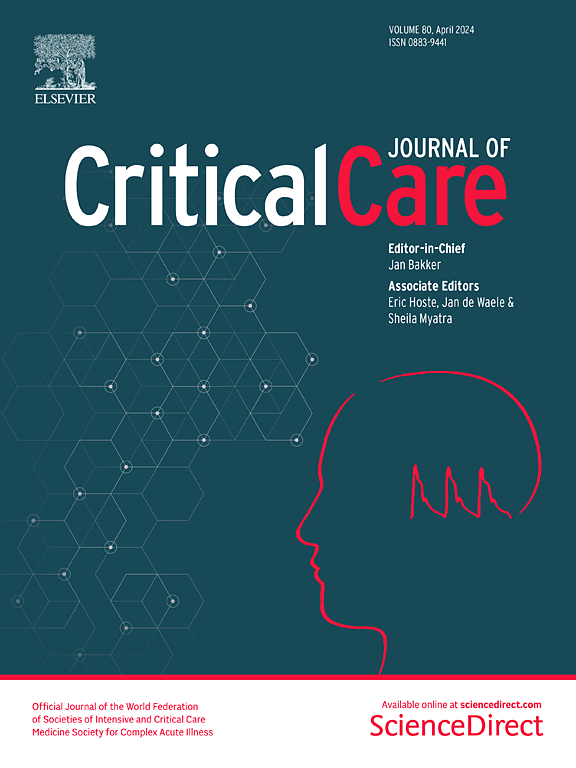Cerebral physiologic insult burden in acute traumatic neural injury: a Canadian High Resolution-TBI (CAHR-TBI) descriptive analysis
IF 8.8
1区 医学
Q1 CRITICAL CARE MEDICINE
引用次数: 0
Abstract
Over the recent decades, continuous multi-modal monitoring of cerebral physiology has gained increasing interest for its potential to help minimize secondary brain injury following moderate-to-severe acute traumatic neural injury (also termed traumatic brain injury; TBI). Despite this heightened interest, there has yet to be a comprehensive evaluation of the effects of derangements in multimodal cerebral physiology on global cerebral physiologic insult burden. In this study, we offer a multi-center descriptive analysis of the associations between deranged cerebral physiology and cerebral physiologic insult burden. Using data from the Canadian High-Resolution TBI (CAHR-TBI) Research Collaborative, a total of 369 complete patient datasets were acquired for the purposes of this study. For various cerebral physiologic metrics, patients were trichotomized into low, intermediate, and high cohorts based on mean values. Jonckheere–Terpstra testing was then used to assess for directional relationships between these cerebral physiologic metrics and various measures of cerebral physiologic insult burden. Contour plots were then created to illustrate the impact of preserved vs impaired cerebrovascular reactivity on these relationships. It was found that elevated intracranial pressure (ICP) was associated with more time spent with cerebral perfusion pressure (CPP) < 60 mmHg and more time with impaired cerebrovascular reactivity. Low CPP was associated with more time spent with ICP > 20 or 22 mmHg and more time spent with impaired cerebrovascular reactivity. Elevated cerebrovascular reactivity indices were associated with more time spent with CPP < 60 mmHg as well as ICP > 20 or 22 mmHg. Low brain tissue oxygenation (PbtO2) only demonstrated a significant association with more time spent with CPP < 60 mmHg. Low regional oxygen saturation (rSO2) failed to produce a statistically significant association with any particular measure of cerebral physiologic insult burden. Mean ICP, CPP and, cerebrovascular reactivity values demonstrate statistically significant associations with global cerebral physiologic insult burden; however, it is uncertain whether measures of oxygen delivery provide any significant insight into such insult burden.急性创伤性神经损伤的大脑生理损伤负荷:加拿大高分辨率创伤性神经损伤(CAHR-TBI)描述性分析
近几十年来,连续多模态脑生理学监测因其有助于减少中重度急性创伤性神经损伤(也称创伤性脑损伤;TBI)后的继发性脑损伤而越来越受到关注。尽管人们对此兴趣浓厚,但对于多模态脑生理学失调对整体脑生理学损伤负荷的影响,还没有一个全面的评估。在本研究中,我们对脑生理学失常与脑生理学损伤负荷之间的关联进行了多中心描述性分析。利用加拿大高分辨率 TBI(CAHR-TBI)研究合作组织的数据,本研究共获得了 369 个完整的患者数据集。对于各种脑生理指标,根据平均值将患者分为低、中、高三个组群。然后使用 Jonckheere-Terpstra 检验来评估这些脑生理学指标与各种脑生理学损伤负荷指标之间的方向关系。然后绘制等高线图,以说明脑血管反应性保持与受损对这些关系的影响。研究发现,颅内压(ICP)升高与脑灌注压(CPP)为 20 或 22 mmHg 的时间越长、脑血管反应性受损的时间越长有关。脑血管反应性指数升高与 CPP 为 20 或 22 mmHg 的时间越长有关。低脑组织氧饱和度(PbtO2)仅与 CPP < 60 mmHg 的时间越长有显著相关性。低区域血氧饱和度(rSO2)与任何特定的大脑生理损伤负荷测量值都没有统计学意义。平均 ICP、CPP 和脑血管反应性值与总体脑生理学损伤负荷有显著的统计学关联;但是,目前还不能确定氧输送量是否对这种损伤负荷有任何重要影响。
本文章由计算机程序翻译,如有差异,请以英文原文为准。
求助全文
约1分钟内获得全文
求助全文
来源期刊

Critical Care
医学-危重病医学
CiteScore
20.60
自引率
3.30%
发文量
348
审稿时长
1.5 months
期刊介绍:
Critical Care is an esteemed international medical journal that undergoes a rigorous peer-review process to maintain its high quality standards. Its primary objective is to enhance the healthcare services offered to critically ill patients. To achieve this, the journal focuses on gathering, exchanging, disseminating, and endorsing evidence-based information that is highly relevant to intensivists. By doing so, Critical Care seeks to provide a thorough and inclusive examination of the intensive care field.
 求助内容:
求助内容: 应助结果提醒方式:
应助结果提醒方式:


